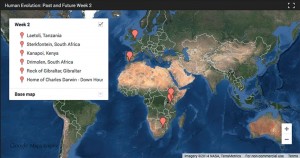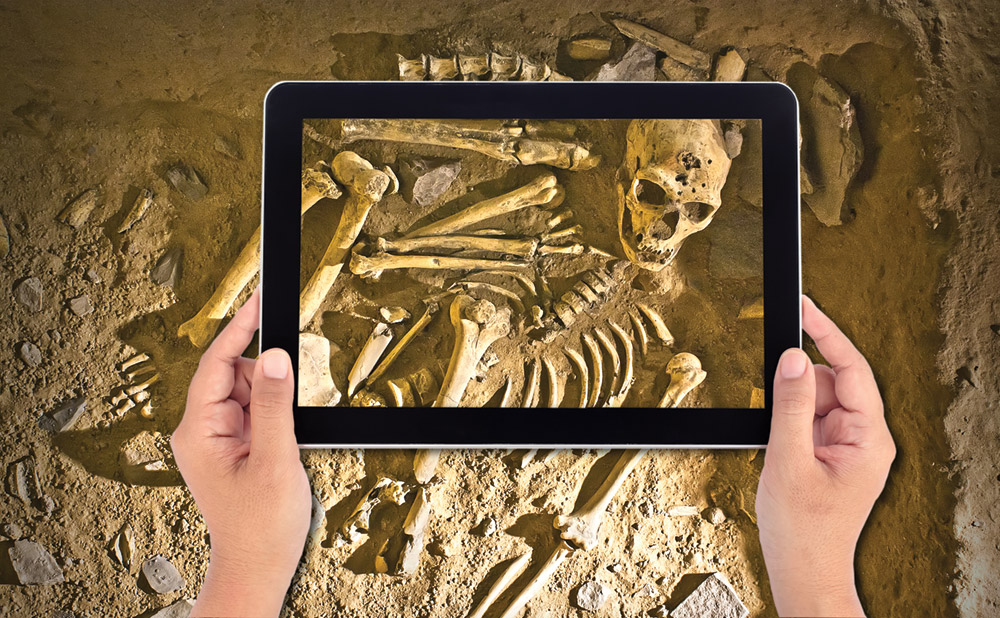Behind the Screens
What did it take to launch a massive open online course? An energetic professor, technical expertise, and hours upon hours of raw video footage.
UW–Madison anthropology professor John Hawks was on location during summer 2013 in Gibraltar, Spain, recording a video lecture for his then-upcoming massive open online course (MOOC) when he received some unwanted attention.
“Filming a #MOOC lecture on the top of the Rock of Gibraltar, and Barbary macaques raid my camera bag. On video. #greatestclassever,” he posted on his Twitter account, @johnhawks.
The curious primates were a fitting addition to Hawks’s course, Human Evolution: Past and Future, one of four MOOCs prepared by UW–Madison faculty and offered through the Coursera online platform during the past year. He was already developing an online version of his popular introductory anthropology class through the Division of Continuing Studies when the UW decided to make its foray into the MOOC market.
The UW ventured into MOOC territory as part of a campus Educational Innovation initiative and an extension of the Wisconsin Idea, former president Charles Van Hise’s vision to spread the university’s reach beyond the confines of campus. Intrigued by the possibilities offered by the emerging online format, Hawks agreed to lead one of the initial offerings.
Some MOOCs are essentially digital archives, conventional lecture courses that are recorded and distributed online. But Hawks has a long-standing interest in using digital tools for research and learning — he’s active on Twitter and has blogged at johnhawks.net since 2004 — and he immediately decided to push the medium to see what was possible.
“We wanted to add things that would be distinctive and use the advantages of the online format,” he says. “We’re taking the students out of the classroom, but we could bring them to the field.”
He assembled a portable video kit and carried it everywhere, recording interviews with experts and lectures at field sites all around the world. He caught colleagues at conferences and at digs, in labs and over beers, and he talked to them about what they do and why, what they’ve learned, and what it means. He sent small cameras into the field with UW students to capture the unique feel of an archaeological site — a mixture of tedium and toil punctuated by flashes of discovery.
Then, working with a team from the academic technology group of the university’s Division of Information Technology (DoIT), he edited dozens of hours of footage into eight units of five- to twenty-minute video segments that were posted on the Coursera site each week from mid-January through mid-March this year.

The videos produced for the MOOC often captured Professor John Hawks at historic field sites, where he served as a tour guide of sorts for his students, giving them unprecedented access to archaeological locations around the world. Courtesy of Division of Information Technology.
The weeks follow the arc of our evolution, from the earliest human-like ancestors through Neanderthals and the rise of complex cultures to modern-day people. “John kept saying, ‘This is the story of us,’ ” says Kari Jordahl, lead instructional designer for the course. “He wanted it to be very much your story — you and where you come in time, that personal connection.”
The response was overwhelming. Two days after the course launched, nearly 10,000 students — I was one of them —had logged more than 31,000 views of the week-one videos and posted almost 4,000 comments in the discussion forums.
In the sea of students, those forums served as a source of community, say graduate teaching assistants Sarah Traynor PhDx’15 and Alia Gurtov MS’13, PhDx’15, with posts ranging from the serious to the lighthearted. “They made a forum called The Pub, and people would go in and chat, [writing], ‘Welcome to the course, grab a beer, and sit down and talk!’ ” says Traynor.
Watching the videos is less like watching documentaries and more like sitting in on real conversations between people who happen to be world-class experts and professional colleagues. Their talks dig into the very roots of the human race.
Of course, what you see on the screen is only part of the story. The entire MOOC team — Hawks, Traynor, Gurtov, three instructional designers, and four video producers — worked behind the scenes to incorporate maps, photos, glossary terms, readings, and other background information into each week’s material to give learners the context they needed to follow along.
“I want to give people the fly-on-the-wall, this-is-how-the-experts-are-talking-about-this experience,” Hawks says. “But that means I have to do a lot of work preparing them to be the fly.”
And what a wall it is. With Hawks as the omnipresent guide, the videos transport viewers to cathedral-like Spanish caverns once home to Neanderthals, into private artifact collections, and to historic field sites such as the Cradle of Humankind in South Africa and Olduvai Gorge in Tanzania, where some of the earliest ancestral species were discovered early in the twentieth century.

Interactive maps played key roles in Hawks’s MOOC. At the start of each week’s video, a map showed students locations that would be covered, providing valuable context for the lesson to come. Courtesy of Division of Information Technology.
These travels are even more momentous than most MOOC students probably realized. Access is a huge issue in archaeology, Hawks explains. Dig sites are restricted and artifacts are scarce, delicate, and often held in small collections with limited accessibility, either by design (to protect ownership) or simply due to lack of resources for promotion and support. Even photos can be hard to obtain.
That lack of access limits both the work that can be done with the materials and who can do it, he says. He viewed the MOOC as an opportunity to create an unprecedented set of resources accessible to anyone with an Internet connection. The course content will continue to be available outside the MOOC through a Creative Commons license (a public copyright license that allows distribution of an otherwise copyrighted work).
“I want material out there that people can use,” he says. “[This course] is just transformative in terms of what we can have for the public.”
For the students, his main goal was to create an experience closer to active science than a classroom. “We’re really trying to tweak people’s expectations about what a class is,” he says.
Through interviews, he takes viewers into the hearts and minds of top researchers in the field, revealing the passion, ingenuity, teamwork, and sometimes extreme physicality demanded by this work. It makes the process of archaeology very human, while showing that the field itself is still evolving.
One segment features South African paleontologist Lee Berger giving a detailed tour of an ancestral species that he discovered only six years ago. Another takes viewers behind the scenes of the Rising Star Expedition, a team formed to excavate an exciting new collection of fossils discovered deep in a South African cave just last October.
Hawks included “past and future” in his course title to emphasize that human evolution is ongoing and that we are very much a part of it. Weekly activities included asking participants to collect information such as foot measurements and tooth impressions to engage students in creating a unique dataset of the diversity of modern people.
While reaping the benefits of the online part of the MOOC, however, the team faced challenges posed by the open aspect.
“One of the really important things when you build an online course is figuring out who is your audience, and what do they know and what do they need to know,” says Jordahl, who has been designing online courses for more than twenty years.
With a MOOC, she says, “We really can’t know the audience. We know they’re probably going to be from sixteen to eighty-six [years old]; they could be anywhere in the world; and some speak English and some don’t. … To me, that was the biggest challenge.”
A follow-up survey by Coursera confirmed Jordahl’s assumptions. In sum, 41,652 people registered from 137 countries, and 20,316 actively participated in some aspect of the course. Only 30 percent of the survey respondents were from the United States. The average age was 40, and 71 percent held a bachelor’s degree or higher. Just 64 percent were native English speakers.
Despite the uncertainty with the course’s target audience, Hawks seems to have hit his mark. UW academic evaluator Josh Morrill’s job was to evaluate participant surveys from throughout the course. “The responses were uniformly and overwhelmingly positive,” he says.
And it seems that MOOCs are fulfilling the Wisconsin Idea’s goal to reach into new territory: fewer than 10 percent of the survey respondents had any prior affiliation with the UW. What’s more, people seemed to connect with this class on an unusually personal level.
“I think in this Hawks MOOC, participants related to him in the way you relate to your favorite TV show. People talked about John as if they knew him,” Morrill says. “People indicated they would wait every Tuesday until new information was posted. They were so sad that it was being taken ‘off the air’ when the MOOC ended.”
At the end of the course, 1,707 students requested a certificate of completion. Many MOOC critics point to low completion rates as a sign that participants do not value the experience. But Morrill says that this strict definition does not account for qualitative value in a setting driven by internal, not external, motivations. It also discounts the experiences of the thousands who participate without requesting documentation, he adds.
Gurtov agrees: “[Students are] there because they genuinely want to learn the information. This is a pure learning experience, and we get to ride along.”
In the official data, I probably looked like an under-engaged student. I watched only a few videos each week, and I missed an entire unit when life got in the way. I rarely visited the discussion forums, and despite the best of intentions, did not dig into the additional resources.
Yet, I enjoyed the experience greatly. Though I skipped the forums, I found community in a small group of UW staff taking the course. Several months later, I recall few facts, but I retain my sense of discovery and awe. The study of human evolution is more real to me now — I’ve seen the people, the places they work, and their diligence and joy.
The end of the course feels like a launching point, giving me a mental framework into which I hope to fit future learning experiences. I don’t yet know what those will be; as of press time, no decision had been made on whether Hawks’s course or the other first-round MOOCs will be repeated, but a second round of six new courses will begin in 2015.
Jill Sakai PhD’06, communications director for the UW’s Office of Sustainability and a freelance writer, will never outgrow being a student.
Published in the Fall 2014 issue



Comments
Abigail Quart October 2, 2014
It was a WONDERFUL course. I didn’t go for the certificate but I watched every lecture and took the quizzes (mostly). And I also want the show to go on!
Kyle Spangenberger October 2, 2014
As someone who took Hawks’s course at the UW, and didn’t partake in the MOOC, I would love to revisit this subject with this professor who teaches with such passion and energy. I really hope they bring it back to I can catch it the next time around.
Brian Stone October 7, 2014
I have a PhD in an unrelated field & I can honestly say Hawks’s MOOC was the best class I have ever taken in my life. I earned a “statement of accomplishment,” which i think means i did a bit less than the 1707 students who earned a “certificate of completion,” but I finished. There may be at least a few thousand more like me – so that certificate of completion # may be an unfairly low estimate of all who made it through the entire wonderful duration. I agree: “greatestclassever” Thank you Dr. Hawks & UW-M!
Keith White October 8, 2014
What a great experience! I took Anthro 100 as a UW freshman in 1966 and J.T. Robinson’s course in organic evolution in 1969. Professor Hawke’s course was an exciting reintroduction to the field. I earned a “statement of accomplishment” and looked forward to each lecture, video and forum.
Terry October 17, 2014
I did this course and achieved’ Statement of Accomplishment with distinction’. I really worked hard at it, especially the essay,though I got into a tangle over it. Having started on my future evolutionary path there was no turning back. At 85 I must have been the oldest.